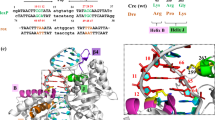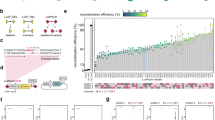Abstract
The Cre/loxP system is widely used as a genetic tool to manipulate DNA. Cre recombinase catalyzes site-specific recombination between 34 bp loxP sites. Each loxP site is recognized by two Cre molecules assuming a cleaving (CreC) and non-cleaving (CreNC) activity. Despite the symmetry in the sequences of the arms of loxP, available biochemical data show strong evidence that the recombination reaction is asymmetric with a preferred strand exchange order. The asymmetry comes from the spacer separating the two sets of palindromic arms of the loxP sequence. However, it remains to be understood how this preferential order is established. We apply computational structure-based methods and perform a thorough detailed analysis of available structural and biochemical information on the Cre/loxP system in order to investigate such asymmetry in the recombination, and we propose a rationale to explain the determinants favoring the strand exchange order. We show that the structural properties of the DNA flanking sequence of the spacer guide the recombination, and we establish the role of residues R118, R121 and K122 from CreC, which contact the spacer region and by clamping the DNA inhibit the cleavage on the second arm of loxP. Our studies give an atomistic insight on the synapsis state of the recombination process in the Cre/loxP system and highlight the importance of the flexibility and other intrinsic properties of the flanking regions of the DNA spacer to establish a preferential strand exchange order.






Similar content being viewed by others
Abbreviations
- CreC :
-
Cleaving Cre recombinase
- CreNC :
-
Non-cleaving Cre recombinase
- bp:
-
DNA base pair
- Sp:
-
DNA spacer
- HJ:
-
DNA Holliday junction
- BS:
-
Bottom DNA strand
- TS:
-
Top DNA strand
- NpN:
-
Dinucleotide step
- MD:
-
Molecular dynamics
- PDB:
-
Brookhaven Protein data bank
- RMSD:
-
Root-mean-square deviation of atomic positions
- RMSDbck :
-
Root-mean-square deviation of backbone atomic positions
- Hb:
-
Hydrogen bond
- ONIOM:
-
Gaussian’s Our own N-layered Integrated molecular Orbital and molecular Mechanics
- AMBER:
-
Assisted Model Building with Energy Refinement
- TRX scale:
-
Twist, Roll, and X-disp (base pair displacement) scale
- QM:
-
Quantum mechanics
- MM:
-
Molecular Mechanics
- QM/MM:
-
Hybrid quantum mechanics/molecular mechanics
- QM/MD:
-
Hybrid quantum mechanics/molecular dynamics
- mG:
-
DNA minor groove
References
Grindley ND, Whiteson KL, Rice PA (2006) Mechanisms of site-specific recombination. Annu Rev Biochem 75:567–605
Hoess R, Wierzbicki A, Abremski K (1987) Isolation and characterization of intermediates in site-specific recombination. Proc Natl Acad Sci USA 84(19):6840–6844
Ghosh K, Lau CK, Gupta K, Van Duyne GD (2005) Preferential synapsis of loxP sites drives ordered strand exchange in Cre–loxP site-specific recombination. Nat Chem Biol 1(5):275–282
Lee L, Chu LC, Sadowski PD (2003) Cre induces an asymmetric DNA bend in its target loxP site. J Biol Chem 278(25):23118–23129
Lee L, Sadowski PD (2001) Directional resolution of synthetic holliday structures by the Cre recombinase. J Biol Chem 276(33):31092–31098
Lee L, Sadowski PD (2003) Sequence of the loxP site determines the order of strand exchange by the Cre recombinase. J Mol Biol 326(2):397–412
Lee G, Saito I (1998) Role of nucleotide sequences of loxP spacer region in Cre-mediated recombination. Gene 216(1):55–65
Ghosh K, Guo F, Van Duyne GD (2007) Synapsis of loxP sites by Cre recombinase. J Biol Chem 282(33):24004–24016
Ennifar E, Meyer JE, Buchholz F, Stewart AF, Suck D (2003) Crystal structure of a wild-type Cre recombinase–loxP synapse reveals a novel spacer conformation suggesting an alternative mechanism for DNA cleavage activation. Nucl Acid Res 31(18):5449–5460
Gelato KA, Martin SS, Baldwin EP (2005) Reversed DNA strand cleavage specificity in initiation of Cre–loxP recombination induced by the His289Ala active-site substitution. J Mol Biol 354(2):233–245
Martin SS, Pulido E, Chu VC, Lechner TS, Baldwin EP (2002) The order of strand exchanges in Cre–loxP recombination and its basis suggested by the crystal structure of a Cre–loxP Holliday junction complex. J Mol Biol 319(1):107–127
Van Duyne GD (2001) A structural view of Cre–loxp site-specific recombination. Annu Rev Biophys Biomol Struct 30:87–104
Guo F, Gopaul DN, van Duyne GD (1997) Structure of Cre recombinase complexed with DNA in a site-specific recombination synapse. Nature 389(6646):40–46
Guo F, Gopaul DN, Van Duyne GD (1999) Asymmetric DNA bending in the Cre–loxP site-specific recombination synapse. Proc Natl Acad Sci USA 96(13):7143–7148
Pinkney JN, Zawadzki P, Mazuryk J, Arciszewska LK, Sherratt DJ, Kapanidis AN (2012) Capturing reaction paths and intermediates in Cre–loxP recombination using single-molecule fluorescence. Proc Natl Acad Sci USA 109(51):20871–20876
Heddi B, Foloppe N, Oguey C, Hartmann B (2008) Importance of accurate DNA structures in solution: the Jun–Fos model. J Mol Biol 382(4):956–970
Heddi B, Foloppe N, Bouchemal N, Hantz E, Hartmann B (2006) Quantification of DNA BI/BII backbone states in solution. Implications for DNA overall structure and recognition. J Am Chem Soc 128(28):9170–9177
Heddi B, Foloppe N, Hantz E, Hartmann B (2007) The DNA structure responds differently to physiological concentrations of K+ or Na+. J Mol Biol 368(5):1403–1411
Winger RH, Liedl KR, Pichler A, Hallbrucker A, Mayer E (1999) Helix morphology changes in B-DNA induced by spontaneous B(I) ⟺ B(II) substrate interconversion. J Biomol Struct Dyn 17(2):223–235
Djuranovic D, Hartmann B (2004) DNA fine structure and dynamics in crystals and in solution: the impact of BI/BII backbone conformations. Biopolymers 73(3):356–368
Svozil D, Kalina J, Omelka M, Schneider B (2008) DNA conformations and their sequence preferences. Nucl Acid Res 36(11):3690–3706
Heddi B, Abi-Ghanem J, Lavigne M, Hartmann B (2010) Sequence-dependent DNA flexibility mediates DNase I cleavage. J Mol Biol 395(1):123–133
Lee L, Sadowski PD (2003) Identification of Cre residues involved in synapsis, isomerization, and catalysis. J Biol Chem 278(38):36905–36915
Rohs R, West SM, Sosinsky A, Liu P, Mann RS, Honig B (2009) The role of DNA shape in protein-DNA recognition. Nature 461(7268):1248–1253
Hizver J, Rozenberg H, Frolow F, Rabinovich D, Shakked Z (2001) DNA bending by an adenine–thymine tract and its role in gene regulation. Proc Natl Acad Sci USA 98(15):8490–8495
Jorgensen WL, Chandrasekhar J, Madura JD, Impey RW, Klein ML (1983) Comparison of simple potential functions for simulating liquid water. J Chem Phys 79:926–935
Mahoney M, Jorgensen W (2000) A five-site model for liquid water and the reproduction of the density anomaly by rigid, nonpolarizable potential functions. J Chem Phys 112(20):8910–8922
Berendsen HJC, Postma JPM, van Gunsteren WF, Dinola A, Haak JR (1984) Molecular dynamics with coupling to an external bath. J Chem Phys 81(8):3684–3690
van Gunsteren WF, Berendsen HJC (1977) Algorithms for macromolecular dynamics and constraint dynamics. Mol Phys 34(5):1311–1327
Case DA, Darden TA, Cheatham TE III, Simmerling CL, Wang J, Duke RE, Luo R, Crowley M, Walker RC, Zhang W, Merz KM, Wang B, Hayik S, Roitberg A, Seabra G, Kolossváry I, Wong KF, Paesani F, Vanicek J, Wu X, Brozell SR, Steinbrecher T, Gohlke H, Yang L, Tan C, Mongan J, Hornak V, Cui G, Mathews DH, Seetin MG, Sagui C, Babin V, Kollman PA (2008) AMBER 10. University of California, San Francisco
Perez A, Marchan I, Svozil D, Sponer J, Cheatham TE 3rd, Laughton CA, Orozco M (2007) Refinement of the AMBER force field for nucleic acids: improving the description of alpha/gamma conformers. Biophys J 92(11):3817–3829. doi:10.1529/biophysj.106.097782
Zgarbova M, Luque FJ, Sponer J, Cheatham TE 3rd, Otyepka M, Jurecka P (2013) Toward improved description of DNA backbone: revisiting epsilon and zeta torsion force field parameters. J Chem Theory Comput 9(5):2339–2354. doi:10.1021/ct400154j
Heddi B, Oguey C, Lavelle C, Foloppe N, Hartmann B (2010) Intrinsic flexibility of B-DNA: the experimental TRX scale. Nucl Acid Res 38(3):1034–1047
Bansal M, Bhattacharyya D, Ravi B (1995) NUPARM and NUCGEN: software for analysis and generation of sequence dependent nucleic acid structures. Comput Appl Biosci 11(3):281–287
Abi-Ghanem J, Heddi B, Foloppe N, Hartmann B (2010) DNA structures from phosphate chemical shifts. Nucl Acid Res 38(3):e18
McDonald IK, Thornton JM (1994) Satisfying hydrogen bonding potential in proteins. J Mol Biol 238(5):777–793
Luscombe NM, Laskowski RA, Thornton JM (2001) Amino acid-base interactions: a three-dimensional analysis of protein–DNA interactions at an atomic level. Nucl Acid Res 29(13):2860–2874
Lavery R, Moakher M, Maddocks JH, Petkeviciute D, Zakrzewska K (2009) Conformational analysis of nucleic acids revisited: curves+. Nucl Acid Res 37(17):5917–5929
Team RC, (2012) R: a language and environment for statistical computing
Humphrey W, Dalke A, Schulten K (1996) VMD: visual molecular dynamics. J Mol Graph 14(1):33–38 27–38
Dapprich S, Komáromi I, Byun KS, Morokuma K, Frisch MJ (1999) A new ONIOM implementation in Gaussian98. Part I. The calculation of energies, gradients, vibrational frequencies and electric field derivatives. J Mol Struct 462:1–21
Frisch MJ, Trucks GW, Schlegel HB, Scuseria GE, Robb MA, Cheeseman JR, Scalmani G, Barone V, Mennucci B, Petersson GA, Nakatsuji H, Caricato M, Li X, Hratchian HP, Izmaylov AF, Bloino J, Zheng G, Sonnenberg JL, Hada M, Ehara M, Toyota K, Fukuda R, Hasegawa J, Ishida M, Nakajima T, Honda Y, Kitao O, Nakai H, Vreven T, Montgomery JA, Peralta JE, Ogliaro F, Bearpark M, Heyd JJ, Brothers E, Kudin KN, Staroverov VN, Kobayashi R, Normand J, Raghavachari K, Rendell A, Burant JC, Iyengar SS, Tomasi J, Cossi M, Rega N, Millam JM, Klene M, Knox JE, Cross JB, Bakken V, Adamo C, Jaramillo J, Gomperts R, Stratmann RE, Yazyev O, Austin AJ, Cammi R, Pomelli C, Ochterski JW, Martin RL, Morokuma K, Zakrzewski VG, Voth GA, Salvador P, Dannenberg JJ, Dapprich S, Daniels AD, Farkas O, Foresman JB, Ortiz JV, Cioslowski J, Fox DJ (2009) Gaussian 09,Revision B.01. Gaussian, Inc., Wallingford
Becke AD (1993) A new mixing of Hartree–Fock and local density–functional theories. J Chem Phys 98(2):1372–1377. doi:10.1063/1.464304
Cornell WD, Cieplak P, Bayly CI, Gould IR, Merz KM, Ferguson DM, Spellmeyer DC, Fox T, Caldwell JW, Kollman PA (1995) A second generation force field for the simulation of proteins, nucleic acids, and organic molecules. J Am Chem Soc 117(19):5179–5197
Tao P, Schlegel HB (2010) A toolkit to assist ONIOM calculations. J Comput Chem 31(12):2363–2369
Acknowledgments
The authors thank Ralf Gey for technical support and the ZIH TU Dresden for high-performance computational resources and assistance. We are grateful to Prof. Frank Buchholz, Dr. Maciej Paszkowski-Rogacz, Dr. Janet Chusainow and Dr. Madina Karimova for valuable discussions.
Author information
Authors and Affiliations
Corresponding authors
Electronic supplementary material
Below is the link to the electronic supplementary material.
Rights and permissions
About this article
Cite this article
Abi-Ghanem, J., Samsonov, S.A. & Pisabarro, M.T. Insights into the preferential order of strand exchange in the Cre/loxP recombinase system: impact of the DNA spacer flanking sequence and flexibility. J Comput Aided Mol Des 29, 271–282 (2015). https://doi.org/10.1007/s10822-014-9825-0
Received:
Accepted:
Published:
Issue Date:
DOI: https://doi.org/10.1007/s10822-014-9825-0




